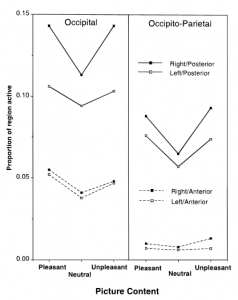Welcome back to my blog series about emotion and our senses! Last post, we learned about our senses in general interact with our emotions. This post will specifically focus on how our visual system helps us navigate the world of emotion. It will also explore how the emotions of those with non-functioning visual systems are impacted.
Think of a mystery movie. The characters just entered somewhere to investigate. What is the first thing that one character says to another? They say “what do you see?” Our eyes help us in our acquisition of information (including emotional information). We understand emotions through visual cues. If you saw someone in tears, what would you say? You would ask them why they were sad. This is due to the aid of our vision in identifying and processing emotion.

What emotion is she displaying? The tears are a visual cue that tell us she is sad.
How we define something as emotional starts with our vision. Schupp et. al (2003) believed that visual cues were responsible for emotional categorization. Participants sawpictures and categorized them as pleasant, unpleasant, or neutral. Their reactions were measured using ERPs. There were stronger, more negative ERP responses in visual areas of the brain. This shows that we quickly identify something as emotional from visual cues. From an evolutionary standpoint this makes sense. You identify someone as sad by tears rather than by a distinct smell. One step further than just categorization, our visual cortex helps us process emotion.
Lang et. al (1998) studied our visual cortex in relation to emotional processing. The Participants were in an fMRI scanner and saw emotional or neutral pictures. Lang found that for emotional pictures there was more activation of the visual cortices. They concluded that emotional processing begins with vision. I agree with this, but I would be curious to see another follow up study. What would happen if the same image was presented more than once? Would the activation lower? It may be possible that the visual activation happens only as a note to the brain to continue to process something. Once something has been fully processed perhaps the visual signals are less important. I have mentioned how vision helps in categorizing and processing emotion, but what about people who have non-functioning visual systems? Can they still emote “normally”?

The athlete on the left is blind. Can you tell that just from her expression? Probably not!
We learn a lot about the world from interacting with others. Galati et. al (2001) believe, however, that our spontaneous emotional expression does not need to be visually learned. They tested this by showing participants videos of blind or sighted children making expressions. They triggered these emotions in various ways such as taking a snack away(anger) or being with a caregiver (happiness). Surprisingly, accurate participant judgment was not significantly different between the two groups. Galati et. al (2001) argue that the physical expression of emotion is independent of our visual learning. They believe spontaneous expressions are thus innate and not visually learned. A similar conclusion was drawn by Matsumoto and Willingham (2009). When they compared and coded photographs of blind and seeing athletes, they found emotional expression to be statistically the same. This emphasizes that emotional expression is independent of visual learning.
Our visual system has a complex relationship with emotion. In some aspects it is very involved: our visual cortex is activated to help us process and identify emotions. In other ways, it is less involved: visual learning of emotion may be minimal. This could mean that expressing emotion (despite it being something that is inherently seen) functions through a different system. This makes sense, since blind individuals still need to express emotions in order to adapt and operate in social situations. Next week, we will see how our sense of hearing affects our emotions. Stay tuned!
References:
[Crying Woman Photograph] Retrieved October 24, 2014, from: http://www.apa.org/monitor/2014/02/cry.aspx
[Blind and Seeing Athlete Photographs] Retrieved October 24, 2014, from: http://blogs.scientificamerican.com/psysociety/2014/02/17/olympics1/
Galati, D., Miceli, R., & Sini, B. (2001). Judging and coding facial expression of emotions in congenitally blind children. International Journal of Behavioral Development, 25(3), 268-278.
Lang, P. J., Bradley, M. M., Fitzsimmons, J. R., Cuthbert, B. N., Scott, J. D., Moulder, B., & Nangia, V. (1998). Emotional arousal and activation of the visual cortex: an fMRI analysis. Psychophysiology, 35(2), 199-210.
Matsumoto, D., & Willingham, B. (2009). Spontaneous facial expressions of emotion of congenitally and noncongenitally blind individuals. Journal of Personality and Social Psychology, 96(1), 1.
Schupp, H. T., Markus, J., Weike, A. I., & Hamm, A. O. (2003). Emotional facilitation of sensory processing in the visual cortex. Psychological science, 14(1), 7-13.

